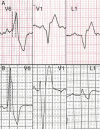Electrocardiographic differentiation of idiopathic right ventricular outflow tract ectopy from early arrhythmogenic right ventricular cardiomyopathy
- PMID: 28431055
- PMCID: PMC5400079
- DOI: 10.1093/europace/euw018
Electrocardiographic differentiation of idiopathic right ventricular outflow tract ectopy from early arrhythmogenic right ventricular cardiomyopathy
Abstract
Aims: The differentiation between idiopathic right ventricular outflow tract (RVOT) arrhythmias and early arrhythmogenic right ventricular cardiomyopathy (ARVC) can be challenging. We aimed to assess whether QRS morphological features and coupling interval of ventricular ectopic beats (VEBs) can improve differentiation between the two conditions.
Methods and results: Twenty desmosomal-gene mutation carriers (13 females, mean age 43 years) with no or mild ARVC phenotypic expression and 33 age- and sex-matched subjects with idiopathic RVOT arrhythmias were studied. All patients exhibited isolated monomorphic VEBs with left bundle branch block/inferior axis morphology. The predictive value of ectopic QRS morphology and coupling interval was evaluated. Five ectopic QRS features were significantly more common in desmosomal-gene mutation carriers than in idiopathic RVOT-ventricular arrhythmia patients: maximal QRS duration >160 ms (60 vs. 27%, P = 0.02), intrinsicoid deflection time >80 ms (65 vs. 24%, P = 0.01), initial QRS slurring (40 vs. 12%, P = 0.04), QS pattern in lead V1 (90 vs. 36%, P < 0.001), and QRS axis >90° in limb leads (60 vs. 24%, P = 0.01). In the multivariate analysis, intrinsicoid deflection time >80 ms [odds ratio (OR) = 9.9], QS pattern in lead V1 (OR = 28), and QRS axis >90° (OR = 5.7) remained independent predictors of early ARVC. The coupling interval did not differ between the two groups.
Conclusions: In patients with RVOT VEBs and no major electrocardiographic or echocardiographic abnormalities, the ectopic QRS morphology aids in the differential diagnosis between idiopathic RVOT arrhythmias and early ARVC.
Keywords: Arrhythmogenic cardiomyopathy; Cardiomyopathy; ECG; Ventricular ectopic beat; Ventricular tachycardia.
© The Author 2016. Published by Oxford University Press on behalf of the European Society of Cardiology.
Figures

Similar articles
-
Electrocardiographic comparison of ventricular arrhythmias in patients with arrhythmogenic right ventricular cardiomyopathy and right ventricular outflow tract tachycardia.J Am Coll Cardiol. 2011 Aug 16;58(8):831-8. doi: 10.1016/j.jacc.2011.05.017. J Am Coll Cardiol. 2011. PMID: 21835319
-
Differentiating arrhythmogenic right ventricular cardiomyopathy from right ventricular outflow tract ventricular tachycardia using multilead QRS duration and axis.Heart Rhythm. 2006 Apr;3(4):416-23. doi: 10.1016/j.hrthm.2005.12.024. Heart Rhythm. 2006. PMID: 16567288
-
The ventricular ectopic QRS interval (VEQSI): Diagnosis of arrhythmogenic right ventricular cardiomyopathy in patients with incomplete disease expression.Heart Rhythm. 2016 Jul;13(7):1504-12. doi: 10.1016/j.hrthm.2016.03.039. Epub 2016 Mar 22. Heart Rhythm. 2016. PMID: 27016477
-
Electrocardiographic features of inherited diseases that predispose to the development of cardiac arrhythmias, long QT syndrome, arrhythmogenic right ventricular cardiomyopathy/dysplasia, and Brugada syndrome.J Electrocardiol. 2000;33 Suppl:1-10. doi: 10.1054/jelc.2000.20360. J Electrocardiol. 2000. PMID: 11265707 Review.
-
Arrhythmogenic right ventricular cardiomyopathy, clinical manifestations, and diagnosis.Europace. 2016 Jul;18(7):965-72. doi: 10.1093/europace/euv340. Epub 2015 Oct 25. Europace. 2016. PMID: 26498164 Review.
Cited by
-
Inherited Arrhythmias in the Pediatric Population: An Updated Overview.Medicina (Kaunas). 2024 Jan 3;60(1):94. doi: 10.3390/medicina60010094. Medicina (Kaunas). 2024. PMID: 38256355 Free PMC article. Review.
-
How to evaluate premature ventricular beats in the athlete: critical review and proposal of a diagnostic algorithm.Br J Sports Med. 2020 Oct;54(19):1142-1148. doi: 10.1136/bjsports-2018-100529. Epub 2019 Sep 3. Br J Sports Med. 2020. PMID: 31481389 Free PMC article. Review.
-
Unlocking the enigma: decoding premature ventricular complexes for effective clinical assessment and risk management.Eur Heart J Suppl. 2024 Apr 17;26(Suppl 1):i23-i28. doi: 10.1093/eurheartjsupp/suae006. eCollection 2024 Apr. Eur Heart J Suppl. 2024. PMID: 38867874 Free PMC article.
-
[Current strategies in the treatment of ventricular tachycardia by catheter ablation : A review].Herz. 2018 Nov;43(7):628-632. doi: 10.1007/s00059-017-4615-9. Epub 2017 Sep 7. Herz. 2018. PMID: 28884341 Review. German.
-
Interpolated junctional extrasystoles mimicking complex polymorphic ventricular arrhythmias in a healthy young athlete: a case report.Eur Heart J Case Rep. 2024 Jan 11;8(2):ytae012. doi: 10.1093/ehjcr/ytae012. eCollection 2024 Feb. Eur Heart J Case Rep. 2024. PMID: 38313322 Free PMC article.
References
-
- Lerman BB. Mechanism, diagnosis, and treatment of outflow tract tachycardia. Nat Rev Cardiol 2015;12:597–608. - PubMed
-
- Corrado D, Basso C, Leoni L, Tokajuk B, Turrini P, Bauce B et al. . Three-dimensional electroanatomical voltage mapping and histologic evaluation of myocardial substrate in right ventricular outflow tract tachycardia. J Am Coll Cardiol 2008;51:731–9. - PubMed
-
- Thiene G, Nava A, Corrado D, Rossi L, Pennelli N. Right ventricular cardiomyopathy and sudden death in young people. N Engl J Med 1988;318:129–33. - PubMed
MeSH terms
LinkOut - more resources
Full Text Sources
Other Literature Sources

